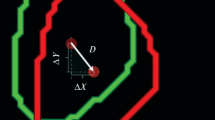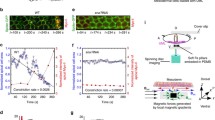Abstract
Influence of the relaxation of mechanical tensions upon collective cell movements, shape formation, and expression patterns of tissue-specific genes has been studied in Xenopus laevis embryos. We show that the local relaxation of tensile stresses within the suprablastoporal area (SBA) performed at the early-midgastrula stage leads to a complete arrest of normal convergent cell intercalation towards the dorsal midline. As a result, SBA either remains nondeformed or protrudes a strip of cells migrating ventralwards along one of the lateral lips of the opened blastopore. Already, few minutes later, the tissues in the ventral lip vicinity undergo abnormal transversal contraction/longitudinal extension resulting in the abnormal cell convergence toward ventral (rather than dorsal) embryo midline. Within a day, the dorsally relaxed embryos acquire pharyngula-like shapes and often possess tail-like protrusions. Their antero-posterior and dorso-ventral polarity, as well as expression patterns of pan-neural (Sox3), muscular cardiac actin, and forebrain (Otx2) genes substantially deviate from the normal ones. We suggest that normal gastrulation is permanently controlled by mechanical stresses within the blastopore circumference. The role of tissue tensions in regulating collective cell movements and creating pharyngula-like shapes are discussed.








Similar content being viewed by others
References
Beloussov LV, Grabovsky VI (2006) Morphomechanics: goals, basic experiments and models. Int J Devel Biol 50:81–92
Beloussov LV, Dorfman JG, Cherdantzev VG (1975) Mechanical stresses and morphological patterns in amphibian embryos. J Embryol exp Morphol 34:559–574
Beloussov LV, Louchinskaia NN, Stein AA (2000) Tension-dependent collective cell movements in the early gastrula ectoderm of Xenopus laevis embryos. Dev Genes Evol 210:92–104
Beloussov LV, Louchinskaia NN, Ermakov AS, Glagoleva NS (2006) Gastrulation in amphibian embryos, regarded as a succession of biomechanical feedback events. Int J Devel Biol 50:113–122
Davidson LA, Keller R, DeSimone D (2004) Patterning and tissue movements in a novel explant preparation of the marginal zone of Xenopus laevis. Gene Expression Patterns 4:457–466
Ermakov AS, Beloussov LV (1998) Morphogenetical and differentiation consequences of the relaxation of mechanical tensions in Xenopus laevis blastula. Ontogenez (Russ J Devel Biol) 29:450–458
Ewald AJ, Peyrot SM, Tyszka MJ, Fraser SE, Wallingford JB (2004) Regional requirements for Dishevelled signaling during Xenopus gastrulation: separable effects on blastopore closure, mesendoderm internalization and archenteron formation. Development 131:6195–6209
Farge E (2003) Mechanical induction of Twist in the Drosophila foregut/stomodeal primordium. Curr Biol 13:1365–1377
Gordon R (2006) Mechanics in embryogenesis and embryonics: prime mover or epiphenomenon? Int J Devel Biol 50:243–253
Harland RM (1991) In situ hybridization: an improved whole-mount method for Xenopus embryos. Methods Cell Biol 36:685–695
Hutson MS, Tokutake Y, Chang M-S, Bloor JW, Venakides S, Kiehart DP, Edwards GS (2003) Forces for morphogenesis investigated with laser microsurgery and quantitative modeling. Science 300:145–149
Ingber DE (2006) Mechanical control of tissue morphogenesis during embryonic development. Int J Devel Biol 50:255–266
Keller R, Danilchik M (1988) Regional expression, pattern and timing of convergence and extension during gastrulation of Xenopus laevis. Development 103:193–209
Keller RL, Davidson A, Edlund T, Elul M, Shook D, Skoglund P (2000) Mechanisms of convergence and extension by cell intercalation. Philos Trans R Soc Lond B Biol Sci 355:897–922
Lamb TM, Knecht AK, Smith WC, Stachel SE, Economides AN, Stahl N, Yancopolous GD, Harland RM (1993) Neural induction by the secreted polypeptide noggin. Science 262:713–718
Masazumi T, Concha ML (2001) Vertebrate gastrulation: Calcium waves orchestrate cell movements. Curr Biol 11:R470–R472
McBeath R, Pirone DM, Nelson CM, Bhadriraju K, Chen CS (2004) Cell shape, cytoskeletal tension, and RhoA regulate stem cell lineage commitment. Dev Cell 6:483–495
Mohun TJ, Brennan S, Dathan N, Fairman S, Gurdon JB (1984) Cell typespecific activation of actin genes in the early amphibian embryo. Nature 311:716–721
Nieuwkoop PD, Faber J (1956) Normal table of Xenopus laevis (Daudin). North-Holland, Amsterdam
Pennisi E (1997) Haeckel’s embryos: fraud rediscovered. Science 277:1435
Peralta XG, Toyama Y, Hutson MS, Montague R, Venakides S, Kiehart DP, Edwards GS (2007) Upregulation of forces and morphogenic asymmetries in dorsal closure during Drosophila development. Biophys J 92:2583–2596
Raff RA (1994) Developmental mechanisms in the evolution of animal form: origins and evolvability of body plants. In: Bengston S (ed) Early Life on Earth. Columbia University Press, New York, pp 489–500
Shih J, Keller R (1992a) Patterns of cell motility in the organizer and dorsal mesoderm of Xenopus laevis. Development 116:915–930
Shih J, Keller R (1992b) The epithelium of the dorsal marginal zone of Xenopus has organizer properties. Development 116:887–899
Troshina TG, Beloussov LV (2009) Mechanodependent cell movements in the axial organs of Xenopus gastrulae. Ontogenez (Russ J Dev Biol) 40(20) (in press)
Unterseher F, Hefele JA, Giehl K, Eddy M, De Robertis EM, Wedlich D, Schambony A (2004) Paraxial protocadherin coordinates cell polarity during convergent extension via Rho A and JNK. EMBO J 23:3259–3269
Wilson P, Keller R (1991) Cell rearrangements during gastrulation of Xenopus: direct observations of cultured explants. Development 112:289–300
Acknowledgments
This study was supported by the Russian Fund for Fundamental Investigations (RFFI), grant # 05-04-48681.
Author information
Authors and Affiliations
Corresponding author
Additional information
Communicated by T. Hollemann
Rights and permissions
About this article
Cite this article
Kornikova, E.S., Korvin-Pavlovskaya, E.G. & Beloussov, L.V. Relocations of cell convergence sites and formation of pharyngula-like shapes in mechanically relaxed Xenopus embryos. Dev Genes Evol 219, 1–10 (2009). https://doi.org/10.1007/s00427-008-0259-3
Received:
Accepted:
Published:
Issue Date:
DOI: https://doi.org/10.1007/s00427-008-0259-3




